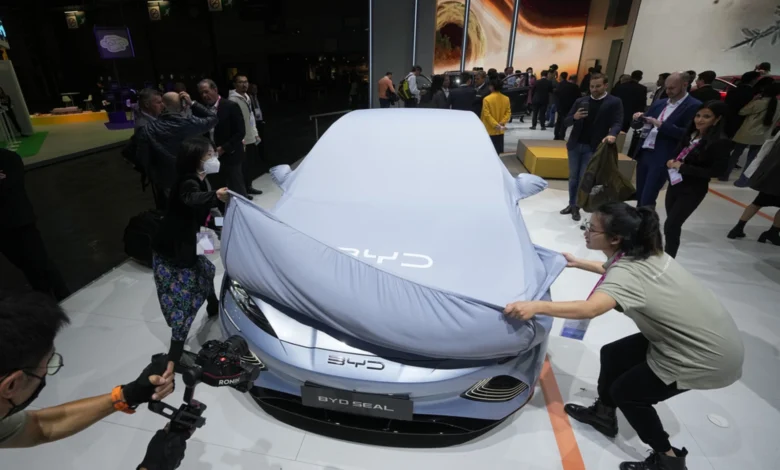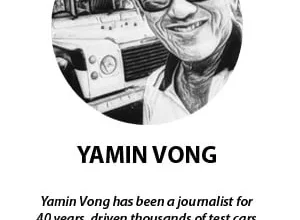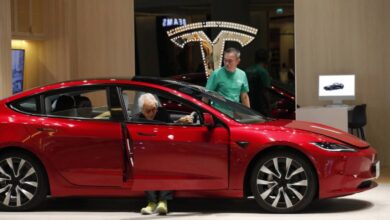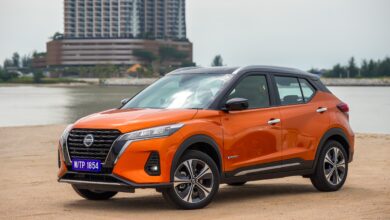Chinese, European automakers face off at Paris car show

[ad_1]
PARIS: Chinese and European automakers are going head-to-head at the Paris car show today, with tensions running high as the EU gears up to impose hefty import tariffs on Chinese-made electric vehicles and the industry struggles with weak demand.
This year’s event – the largest car show in Europe – comes at a pivotal time. Struggling European automakers need to prove they are still in the game, while Chinese rivals are aiming to get a foothold in a competitive market.
“This is China versus Europe and this is the ring they’ve chosen to fight in,” said Phil Dunne, a managing director at strategy consultancy Stax.
“The Europeans are saying this is our territory and the Chinese are coming to stake their claim.”
Nine Chinese brands including BYD and Leapmotor are unveiling their latest models at this year’s event, according to Paris auto show CEO Serge Gachot. That is the same as in 2022 when they made up almost half the brands present.
This year, they will only account for about a fifth of the brands thanks to a much stronger showing from Europe’s auto industry – a sign of its determination to defend its home turf.
Earlier this month, EU member states narrowly backed import duties on Chinese-made EVs of up to 45%, meant to counter what the European Commission says are unfair subsidies from Beijing to Chinese manufacturers. Beijing denies unfair competition and has threatened counter-measures.
While Chinese automakers have criticised the EU’s move, they are pressing ahead with European expansion plans and so far none has said it will raise prices to cover the duties.
China’s GAC told Reuters on Sunday that the show marked the launch of its European ambitions, while compatriot Leapmotor said on Monday it aimed to have 500 points of sale in Europe by the end of 2025.
Chinese EV makers like BYD have so far priced their vehicles slightly below their European rivals, giving them an advantage. That will also help offset lower margins at home. Like Japanese and South Korean automakers before them, they are also touting better equipment and offering more features as standard.
Yet even BYD, which already sells EVs across much of Europe and sponsored the European soccer championships this summer, still has relatively low brand recognition, so will hope to make a splash with the electric Sea Lion 07 SUV it is due to launch.
Newer Chinese entrants like Dongfeng, Seres and FAW will also be showing off new models as they seek overseas EV sales to offset a weak home market and a vicious price war there.
China’s passenger vehicle sales rose 4.3% in September from a year ago, snapping five months of decline with a boost from a government subsidy to encourage trade-ins as part of a broader stimulus package. Europe’s sales hit a three-year low in August.
In another blow for the EV market, the French government said on Thursday it would reduce its support for EV buyers, joining Germany which ended its subsidy scheme late last year.
‘Alarm bells’
Chinese automakers also need to do well in Europe because they have been shut out of the US market.
The Biden administration has imposed a 100% tariff on Chinese-made EVs and last month proposed banning key Chinese software and hardware in connected vehicles.
Europe’s automakers, meanwhile, have hit a rough patch, with Volkswagen, Mercedes-Benz and BMW all issuing profit warnings largely because of the weak Chinese market. Stellantis slashed its earnings forecast because of inventory problems at its US business.
Stellantis CEO Carlos Tavares today declined to rule out job cuts or offloading brands in a challenging market.
“We will need to make big efforts”, he told French radio station RTL, adding it was up to customers to decide which brands had a future.
“It’s the clients, not me, but there is no taboo.”
Volkswagen is also locked in a battle with powerful unions over cost cuts that could see it close German factories for the first time and cut thousands of jobs.
The Europeans are struggling to compete with Chinese rivals’ lower costs and their ability to develop new EVs in just two years, at least twice as fast as traditional Western automakers.
“The Europeans have massive alarm bells ringing,” Stax’s Dunne said. “They have recognised they need to do something pretty radical and they only have a couple of years to do it.”
[ad_2]





